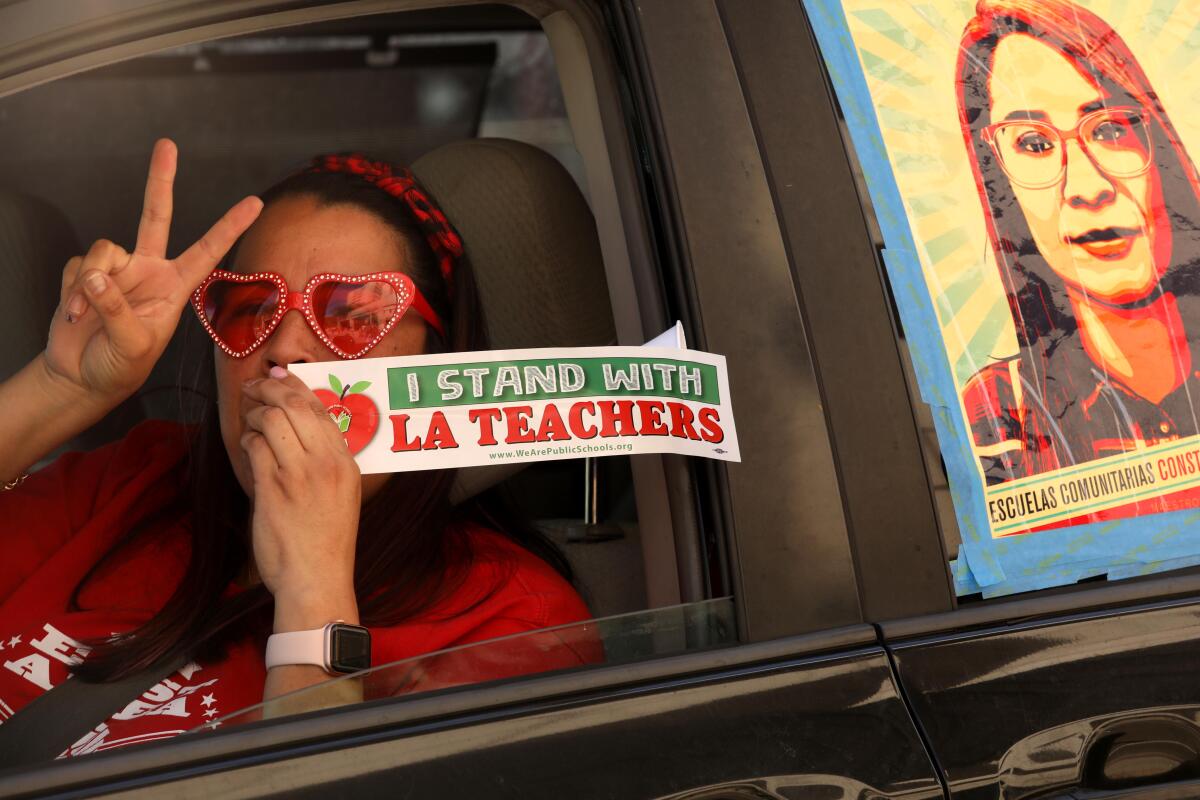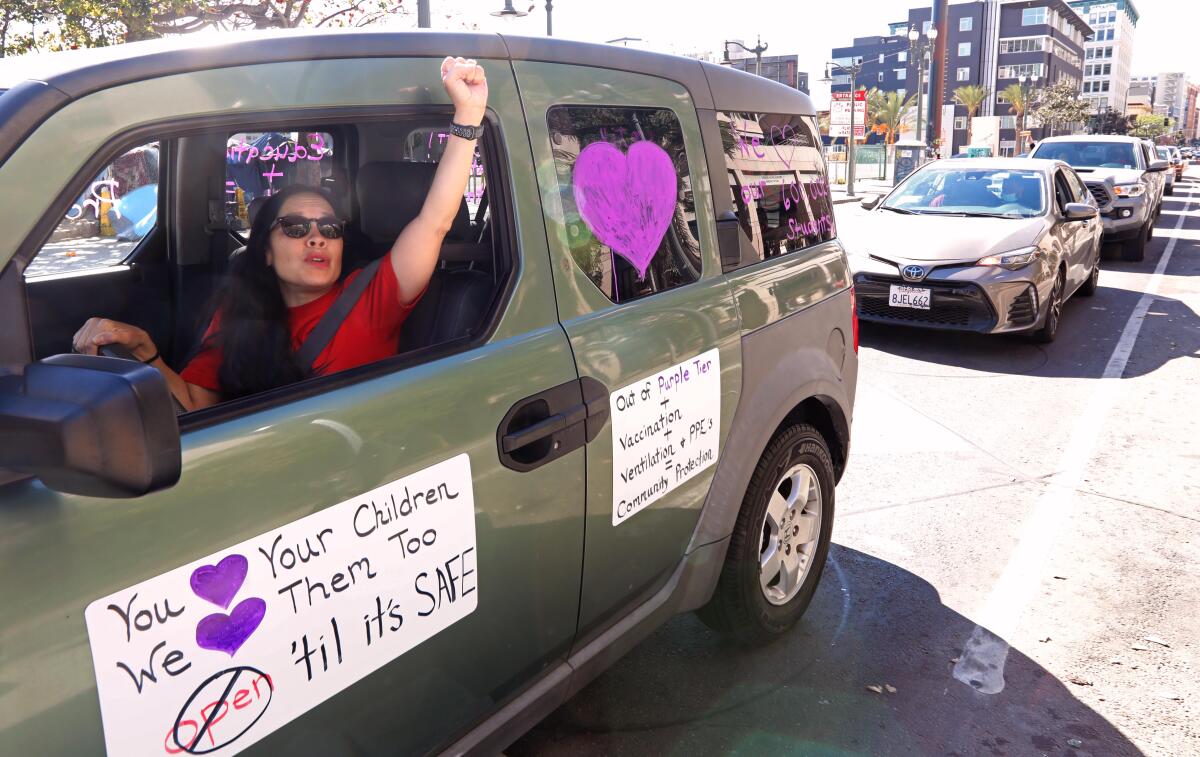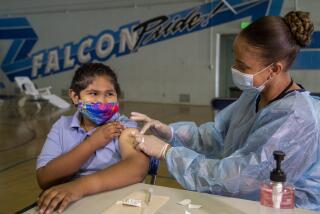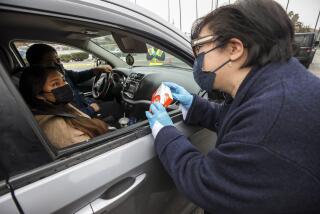No quick path to reopening L.A. Unified is emerging as school year slips away

- Share via
Gov. Gavin Newsom’s new plan to vaccinate school staff more quickly does little to move campuses toward reopening in Los Angeles, where the teachers union remains opposed until community infection rates drop further and vaccines take full effect for returning workers — calling into question whether a robust return to in-person instruction is possible before the end of the school year.
The union’s posture — similar to that of school employee unions in San Francisco and of the California Teachers Assn. — comes as union leaders in the nation’s second-largest school district continue protracted negotiations with officials over what a return to school will look like and as parents in diverse areas of the city express passionate and opposing views over reopening.
United Teachers Los Angeles President Cecily Myart-Cruz said the union is holding firm to protect the health of students and their families as well as its members, who include teachers, librarians, counselors and nurses.
“Now more than ever we are feeling the pressure to return to physical schools before we have the necessary conditions and measures in place to ensure the safety of everyone. And the pressure is coming from all sides,” Myart-Cruz said in a Friday broadcast to members and the public. “Local and state officials did not help create the right conditions to reopen schools for in-person instruction and educators are being targeted for trying to protect our students and our communities.”
Myart-Cruz also left open the possibility that union members would refuse to return to work if their safety concerns are not fully addressed. Union members will vote internally to clarify their position in early March, she said.
Schools Supt. Austin Beutner has not announced any firm plans for reopening campuses — and has also echoed concerns that vaccinated school employees and lower coronavirus rates are critical elements to the safe reopening of campuses for the 465,000 students in kindergarten through 12th grade.
The stances of both the union and Beutner are more cautious than the latest guidance from the U.S. Centers for Disease Control and Prevention, which endorses the immediate reopening of elementary campuses, provided they follow strict safety procedures.

Students and parents allied with the union expressed their fears about reopening too quickly during a downtown car caravan rally and news conference Saturday. Parents emphasized that Black and Latino families have been devastated by the virus and said they do not believe community conditions are safe enough to reopen.
“We know that a lot of white parents are calling for the reopening of schools — that is simply not the case with Black parents and other parents of color,” said Jsané Tyler, a district parent. “The majority of us don’t believe that students should be on campus right now because it’s just not safe.”
Speakers said school nurses must be assigned to every campus — which would be a problem given that the district doesn’t have enough nurses. They also called on the district to immediately funnel more resources to improve distance learning and provide more counseling for children, many of whom are dealing with grief on top of academic challenges.
“A lot of the children have lost friends and family,” said parent Ruby Gordillo, her voice cracking with emotion.
Other parent demonstrations have called for a broader or immediate reopening of campuses — or at least for families to have the choice of going back. On Monday, a “Zoom Out” protest is planned by one group.
There has been no definitive recent polling on the views of district parents and the demographic characteristics associated with those who hold differing views.
Under a plan announced Friday by Newsom, the state would set aside 10% of its vaccine supply for school employees and day-care providers beginning March 1. Though the move could add momentum to reopening efforts, vaccine supplies are limited.
Myart-Cruz made it clear that the union does not accept the standard for reopening laid out by the Newsom administration. The governor’s guidelines allow elementary campuses to reopen when a county’s adjusted seven-day average of daily infections falls below 25 cases per 100,000 residents for five consecutive days. L.A. County reached that threshold last Monday, freeing schools to reopen, provided they follow safety rules. Some districts have embraced that option.
L.A. teachers union leaders, however, say that in-person instruction should not resume until cases drop to 7 per 100,000, when the county exits the “purple tier” signifying widespread community transmission.
There is uncertainty over the extent to which a school system can force employees to return.
Unions have noted that California law gives them the right to negotiate over working conditions, a position with a solid legal foundation, according to the California School Boards Assn. But a right to negotiate is not a blanket right to veto a plan to return. And, separately, both the county and the state public health departments say that officials can reopen campuses without union approval, provided there is a documented effort to consult with labor groups.
The Glendale Unified School District announced last week that it is “preparing for the careful and deliberate return of students for on-campus instruction at all elementary schools by the end of March.”
The district reported it had “scheduled negotiations” with its teachers union but clearly wasn’t waiting for the union’s consent to reopen. District leaders also state they are “facilitating partnerships to ensure vaccines are distributed as quickly as possible to teachers and staff who want them once doses become available.”
The county’s second-largest school system — in Long Beach — received praise from Newsom on Friday for establishing a schedule to reopen. However, that effort includes the vaccination of returning employees, something that Newsom opposes as a prerequisite. Waiting for vaccinations, he said, would mean abandoning any hope of returning to campus during the current academic year — a goal he’s not willing to let go of.
Long Beach school staffers have had access to vaccines because that city operates its own health department. The situation looks less promising in other parts of L.A. County, where school employees become eligible for vaccines March 1.
In L.A. County, the governor’s set-aside for the education sector would amount to shots for about 10,000 people per week given the current vaccine supply, according to the state health department.
Those 10,000 doses compare to an estimated 500,000 workers in the education sector, which is defined broadly to include higher education and child care. That sector might even include private nannies.
At a rate of 10,000 per week, it would take nearly a year to vaccinate everyone in this group. And achieving maximum immunity takes five to six weeks after the first of two vaccine doses.
However, 10,000 a week is likely to be the worst-case scenario. The vaccine supply is expected to increase — and a one-dose version also is nearing emergency use authorization. Moreover, school districts can use their share of doses strategically — opening up gradually, targeting the students they feel to be most in need. For example, those teaching kindergarten or those working with English learners or students with disabilities could be prioritized.
The L.A. teachers union is not necessarily opposed to this approach, a union spokeswoman said Friday, a position that offers hope that some L.A. students could receive in-person instruction in the near future.
School board President Kelly Gonez said she would like to prioritize doses for “those who are already reporting in-person every day,” a group that includes food service employees, custodial workers and maintenance crews. Then, she’d like to target educators strategically.
“There is widespread consensus that young students are less likely to contract the virus or spread it,” she said. “I would like to see our early education programs and early elementary grades prioritized, as well as educators who support our children with disabilities. That way, we can reopen sooner for students who have had the most significant challenges in distance learning.”
Until then, L.A. Unified appears to be an outlier even among school systems that are still online; most of these districts seem to be offering some in-person instruction.
Raj Raghavan, a parent at Melrose Elementary School in Fairfax, is frustrated.
“I love the principal and teachers at Melrose,” Raghavan said. “They are terrific, responsive and doing their best in this horrible situation. That said, distance learning is not working for my second-grader.”
More to Read
Sign up for Essential California
The most important California stories and recommendations in your inbox every morning.
You may occasionally receive promotional content from the Los Angeles Times.











